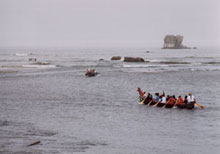
Canoes depart Hoh River Aug. 10. Crossing the shallow bar required great care. (Photo: Al Zob, used with permission)
Journey Within the Journey
By Robert Steelquist
Education Coordinator
Olympic Coast National Marine Sanctuary
Tribal Journeys departed the mouth of Hoh River and headed for Queets River, where the canoes would cross the dangerous river bar and paddle the mile and one-half upstream for welcoming. Blessed with over a week of fine weather and calm seas, the Journey into the ocean had been enjoyable and safe. As the canoe neared its final destination, pullers spirits were high and support boats and ground crews had worked into a fairly easy routine.
The weather forecast called for rising wind and swell and a slight chance of clouds and ocean fog, but nothing serious. Over the last few nights at skippers meetings one speaker after another had emphasized the importance of all the canoes staying together and timing the arrival off the river’s mouth precisely at flood slack tide, when the bars would have the maximum water on them.
Andy Palmer, Jay Moeller and I crewed the Olympic Coast National Marine Sanctuary research vessel Tatoosh. The sanctuary offered Tatoosh as a support boat for the last few perilous days on the rugged outer coast, where conditions could be roughest and help the farthest away. Our offer was warmly received by Journeys’ organizers. We arrived at the Hoh River just in time to see the first canoes bound over the surf at the Hoh River bar and turn southward toward Queets, 13 miles away. The first canoes out fell into the trough, a half-mile offshore, just where the breakers begin to mount up. Light clouds lay on the dark forests, like wisps of mountain goat hair clinging to the tree limbs.
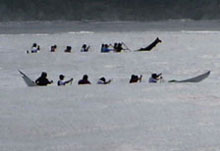
Around noon, a conspicuous swell arises from the Northwest. Mayee (Quinault, in rear) and the Gold River canoe (Mowachaht) play hide and seek just outside the surf near Kalaloch. (Photo: Robert Steelquist, OCNMS)
Tatoosh made its way easily down the coast, as we marveled at the sight of canoes appearing and vanishing in the swells and as the rocks, islands bluffs and forests passed by. We were witnessing a scene that could have been 500 years old. In easy rhythm, paddle blades rose and fell together, occasionally glistening as sunlight caught the water. Other support boats fell into line, spaced evenly along the procession, perhaps three or four canoes apart. Periodically, we’d creep past a canoe, hearing in the distance the voices of the pullers united in song.
Overhead, the clouds began to press down. Soon, the treetops were no longer visible. A bright canopy lay over our heads as the ceiling descended. We noticed a quickening in the breeze and a gradual rise in the swells. Taking conscious note of which canoes we could see, we adjusted our speed to theirs and tried to keep everyone in sight.
At Kalaloch, the bottom fell out of the sky. Within minutes, visibility dropped from miles to 200 feet. Watchful of two canoes close by, our concerns for others immediately grew as radio chatter on VHF increased and other support boats began trying to locate canoes and crews in their vicinity. The orderly procession we had witnessed only an hour earlier had devolved into chaos. Our radar showed us locations of other support boats, we were in radio contact and had full GPS, but we couldn’t see canoes and importantly, many small boats and canoes couldn’t see us. The Journey was in peril.
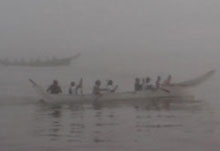
By 2 p.m., fog has descended, isolating canoes from their support boats and each other. Most crews, equipped with GPS and VHF radios proceed cautiously, aware of booming surf nearby. Canoes from Medicine Creek Nation (Nisqually Tribe) and Gold River (Mowachaht) proceed warily. (Photo: Robert Steelquist, OCNMS)
Occasionally, we swept landward of the visible canoes, warning them offshore and away from the swells that formed into breakers nearby. Several canoe crews pulled confidently, using handheld GPS and monitoring their handheld radios. Other crews appeared shaken and discouraged by a situation growing more dangerous.
Over the radio came news that Loo cho eess , the combined Queets/Quinault canoe, had swamped and overturned while crossing the Queets River bar. Our alarm grew. There was no news of the crew’s fate.
Over the radio, Tatoosh skipper Andy Palmer juggled conversations with other support boats. Voices overlapped voices as radio traffic increased, voices tense with anxiety. Gradually skippers of other support vessels began to coordinate. Guy Capoeman, Quinault organizer of the Journey, came on with the news that because of river bar conditions, the flotilla would have to travel all the way to Point Grenville, effectively doubling the day’s effort, but assuring a calmer harbor and easier landing on the beach.
The task of each support boat was now to gather up as many canoes as possible and move slowly en-masse to a rendezvous point off Grenville, all the while surrounded by blinding fog. Our odds at finding everyone seemed slim.
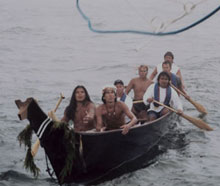
As word of two capsizings reach the flotilla, Journeys leaders elect to call canoes into support boats rather than risk the safety of the crews. The Muckleshoot canoe reluctantly accepts an offer to be towed by Olympic Coast National Marine Sanctuary’s research vessel Tatoosh. (Photo: Al Zob, used with permission)
We were soon overtaken by a small powerboat. It had rescued the Queets/Quinault crew. Shivering and shaken, they requested to come aboard Tatoosh to be warmed and comforted for the long ride home, without their canoe. We hurriedly made room for 14 pullers, some verging on hypothermia. One puller was missing, last seen in the surf clinging to the canoe. All were deeply concerned and fearful of the worst.
In preparing for our mission with the Journey, we anticipated just this situation. We had purchased fleece blankets and plenty of instant soup. Our small galley was soon pumping out warm nourishment to the cold crew. The rear deck hatches, warm from the diesels beneath, were perfect places to have the chilled pullers sit and warm up. We motored south, our entourage increasing as a rag-tag flotilla of small boats, some towing canoes. The buzz over Channel 68 was constant. At one point I stole a quiet moment at Tatoosh’s bow. This far offshore we were encountering common murre pairs—an adult male and a young-of-the-year fledgling. This is how baby murres spend the first summer and fall of their life, alone at sea with “dad.” As our flotilla moved along in the fog, murre fathers would cry out, searching for the babies. In turn the puffy fledglings would answer over the swells. Frantically, they would try to find each other and get out of our way. The call and response reminded me of our own situation—a desperate attempt to locate each other and be reunited safely.
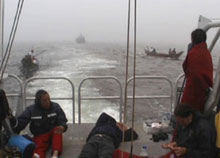
Queets/Qunault canoe Lee-Cho-Eese, one of the canoes that overturns in the surf, escapes tragedy as all pullers are accounted for following swamping and flipping at the mouth of the Queets River. With some nearing hypothermia, the crew is brought aboard Tatoosh and warmed with soup and blankets. (Photo: Robert Steelquist, OCNMS)
Slowly, our raft of vessels got larger. But the news was not getting better. First one, and eventually three of the towed canoes flipped over, swamped and broke their towlines. Unmanned and awash in the wake and swells, the canoes had jerked along like floating matchsticks. Now three canoes were drifting in the fog. Several crews stayed aboard their canoes—Lower Elwha skipper Al Charles worked the helm of the giant 45-foot Spirit Of Elwha, Reg Ward stayed aboard the Muckleshoot canoe to steer and all of the Makah whalers stayed with their canoe, snugly hunkering down and eating smoked salmon.
Progress was painfully slow. Conflicting stories filled the airwaves. Support skippers worked through a list of canoes and crews that they could account for. Still, as many as half the canoes were out of contact, whereabouts unknown. We inched down the coast for hours, making just over 4 knots, a pace that kept the towed canoes manageable. GPS coordinates were relayed around the procession—we would form up as a whole at a meeting place just off Pt. Grenville, where we would turn blindly in toward shore, following the swells into a cove where a large crowd was gathering to meet us.
At about 6 p.m. we reached the coordinates, and found four more support vessels and more canoes awaiting us. We were troubled, however, at the news that two support vessels, each with a canoe in tow, had apparently overshot the rendezvous and were in trouble near the surf. Fourteen people on two small boats were in danger of being swept into the surf. Fuel on the one of the boats was running low and other than radio, the craft carried no navigation equipment. The Coast Guard was searching for them.
From our meeting point, we made the turn, and slowly motored into the fog. Radar and GPS showed us our exact position, but visually, we might just as well have been in outer space for the lack of orientation.
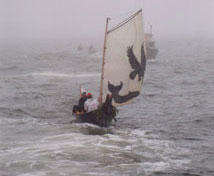
Makah pullers on Aa-Eek-Tuktsh raise sail in the bad weather, preferring to remain with their canoe and under their own power. (Photo: Al Zob, used with permission)
As Tatoosh led the way, the motley armada crept into the cove. Gradually the fog enshrouded, shadowy forms of the rocks and headlands of Pt. Grenville became visible. Faintly, lights shone on shore. Their intensity increased gradually. One, then four, then 15—suddenly the fog lifted to the sight of over 100 cars on the beach, many with headlights on to guide us in. As if a curtain rose, the beach, trees and a throng of people came into sight. We heard a roaring cheer and car horns blared. As if choreographed as a movie ending, the fog rose and the pale flame-like light of the setting sun poured into the scene.
Spontaneously, canoe crews quickly boarded their canoes and pushed off, shouting in synch as they reached the pace of paddling. Headlong toward the beach they raced, driven by adrenalin and relief after hours of doubt and crawling movement. Canoes took off like arrows and toward shore, we saw skiffs head out to meet us. Everyone aboard Tatoosh was energized by the breathtaking suddenness of our arrival. People scrambled to gather their wet belongings. We prepared to debark our passengers, who now numbered 36.
Once the small boats left, we were alone again aboard Tatoosh. We wondered aloud just what we had just experienced—hours of tension with the boat packed with people punctuated with the excitement and relief of the journey’s ending. The emotional range of the day was difficult to completely understand. We maneuvered toward an anchorage in the cove where we could stay the night and avoid the four to six hour return to La Push, where our day had begun.
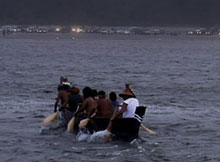
After a harrowing day in the fog, the flotilla is guided by Tatoosh into Grenville Cove on the Quinault Reservation. Fears have mounted on shore as reports of spills, swell and fog reached relatives and supporters on land. As we reach our destination the clouds lift to reveal hundreds who have gathered on the beach to greet the Journey. Muckleshoot pullers explode into action as they race toward the surf and the Journey’s final destination. (Photo: Robert Steelquist, OCNMS)
Just as we set the anchor, backed down the engines and prepared to eat dinner, the Coast Guard reported that they had located the lost boats and their passengers. As suspected, the support boats had overshot Pt. Grenville and were well to the south of us. Our workday was not yet over—we weighed anchor and went out to meet the Coast Guard’s 47-footer arriving with the 14 people, twelve teenagers and two elders. These were apparently the last of the unaccounted-for pullers. In darkness, illuminated by the worklights on Tatoosh and the Coast Guard “47,” we transferred the crews aboard and motored back into the cove to meet an awaiting skiff. Once again it was quiet. Now we really could anchor up for the night and catch some precious sleep.
As Tatoosh rocked gently in the cove, the wind freshened and the cries of seabirds pierced the gusts. Waves slopped against the hull. We divided the night into two-hour anchor watches. Two slept as one stayed up to guard against dragging the anchor. Between 1 and 3 a.m., while I hunkered down in the darkness, the moments and hours of the day played themselves over and over.
During the entire spectacle of Tribal Journeys, I had been conscious of my role as an observer and recorder of a remarkable experience—primarily the experience of others. With the day’s fog, and foggier events, the distinction between observer and participant blurred. In a real way, we became part of the Journey, sharing the best and the worst with the paddlers. Emotionally, we connected at a deep level—equally caught up in the same fears, concerns and hopes and equally relieved at the day’s miraculous outcome. We had shared the Journey and at its end found ourselves in the same great canoe.
Sign up for the Ocean Explorer E-mail Update List.








